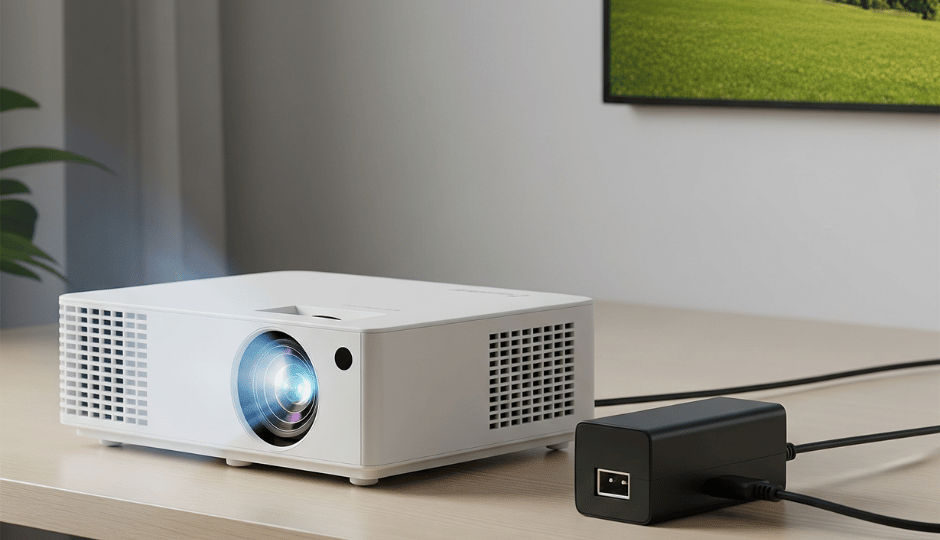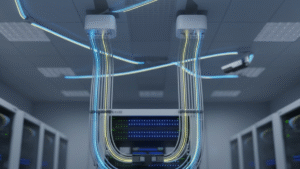Introduction
Portable projectors are increasingly used in business meetings, educational environments, outdoor events, and home entertainment. Their compact size and wireless capabilities have transformed how we share and consume content on the go. However, one often-overlooked yet essential component determines whether a projector can consistently deliver stable brightness and uninterrupted operation: the external power adapter.
This article explores the technical and practical reasons why most portable projectors rely on external power adapters instead of internal power modules, and how the right adapter ensures the projector performs at its full potential.

Why Use an External Power Adapter?
Thermal Management
Portable projectors are compact devices, often housing high-power LED or laser light sources along with digital processing components in a confined space. Integrating the power supply internally would increase the thermal load, potentially leading to overheating. An external power adapter keeps the heat-generating power components separate from the core device, allowing the projector to maintain a stable internal temperature and reduce the risk of thermal failure.
Compact Design and Weight Reduction
One of the main advantages of portable projectors is their small form factor. Including a full AC-DC conversion circuit inside the projector would increase its size and weight. By offloading the conversion function to an external adapter, manufacturers can design slimmer, lighter devices without compromising on performance.
Simplified Maintenance and Flexibility
When the power supply is external, it can be easily replaced in the event of a failure. In contrast, an internal power module would require disassembling the device, increasing repair costs and downtime. External adapters also provide more flexibility for global users, as they can be swapped for region-specific versions or travel adapters that support various input voltages.
The Role of Power Adapters in Projector Performance
Portable projectors require a stable and continuous power supply to operate correctly. The quality and specifications of the power adapter directly influence the device’s brightness, processing stability, and overall performance.
A low-quality or incompatible adapter may result in symptoms such as:
- Screen flickering
- Reduced brightness
- Audio-video synchronization issues
- Spontaneous reboots or shutdowns
- Long-term damage to internal circuits due to voltage instability
High-quality switching power adapters offer the following performance advantages:
- Stable voltage and current output with minimal ripple
- Integrated protection features such as over-voltage, over-current, short-circuit, and thermal protection
- Global voltage input (typically 100–240V) with efficiency ratings that comply with international standards
Typical Power Requirements of Portable Projectors
The power demand of a portable projector depends on several factors, including:
- Brightness level (measured in lumens)
- Projection technology (DLP, LCD, or LED)
- Additional features such as built-in speakers, Wi-Fi modules, auto-focus, or operating systems
As a result, power specifications vary widely. Common power ratings include:
- 12V 2–4A for basic LED projectors
- 15V 2A for mid-range Android-based projectors
- 19V 4.7A or higher for high-resolution or long-throw projectors
Using an adapter that matches the exact voltage and current requirements is critical. Undervoltage can cause startup failures or dim images, while overvoltage risks damaging internal components.
External Adapter vs Internal Battery: A Practical Comparison
Many portable projectors feature built-in rechargeable batteries, which offer convenience for temporary use. However, batteries have limited capacity and cannot sustain high power output over long durations. For example, a projector rated at 60 watts might only run for one hour on battery power. In contrast, when connected to a suitable external power adapter, the device can run continuously at full brightness and functionality without degradation.
While batteries are ideal for short trips or outdoor use, external adapters are indispensable for extended sessions such as:
- Business presentations
- Classroom teaching
- Movie nights
- Exhibition booth displays
Selecting the Right Adapter for Your Projector
When choosing an external power adapter, the following aspects should be carefully evaluated:
- Output voltage and current must match the projector’s specifications exactly.
- The DC connector must be compatible in terms of size and polarity.
- The adapter should hold relevant safety and compliance certifications, such as CE, UL, FCC, or RoHS.
- High efficiency (Level VI or equivalent) is recommended to reduce heat and power waste.
- For use in medical, educational, or government environments, adapters with enhanced EMC and safety ratings are preferred.
It is advisable to use original adapters provided by the manufacturer or to select trusted third-party alternatives with proven quality and protection features.
Conclusion
External power adapters play a far more critical role than simply supplying electricity to a portable projector. They directly influence the stability, brightness, safety, and service life of the device. As portable projectors continue to evolve toward higher resolution and multi-functionality, the importance of reliable, well-matched power solutions only grows.
Whether for professional or personal use, investing in a certified, high-quality external power adapter is essential for getting the best performance out of your portable projector. It ensures not only seamless operation but also protects your device investment in the long run.




